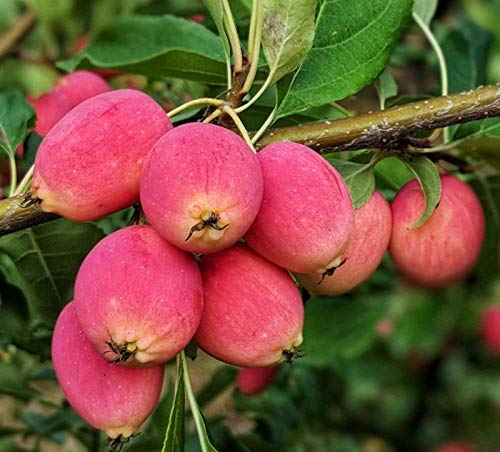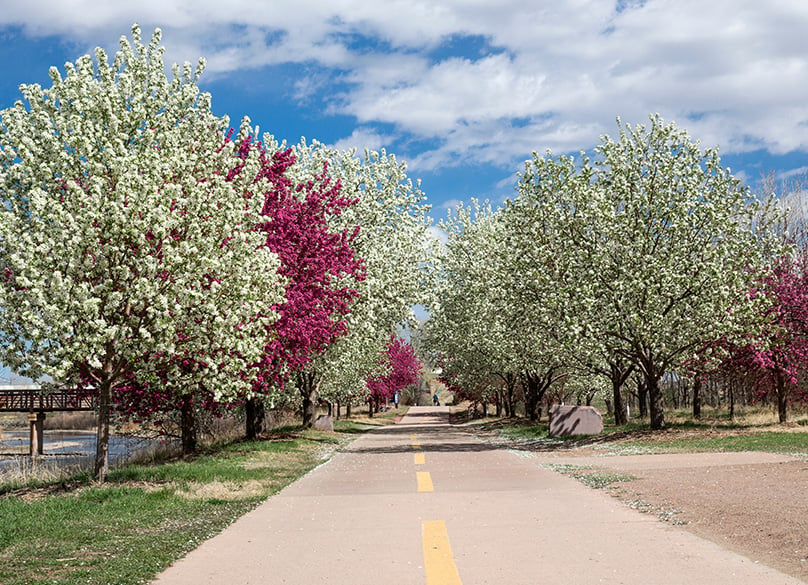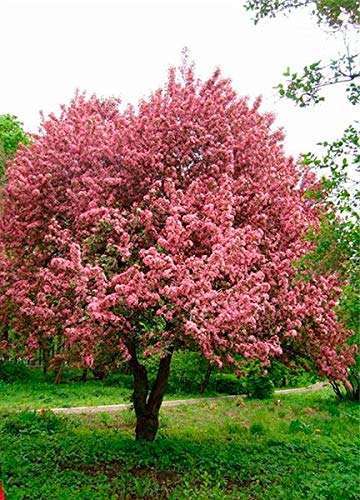Crabapples have a bad reputation. It might surprise you to learn that you can eat plenty of varieties of crabapples, and they’re not the black sheep of the fruit world you thought they were.
In most cases, the buds on crabapple trees are a darker color than the flowers, giving the tree a multi-colored appearance as the flowers open during the summer. Leaf color can vary from green leaves in the spring and summer, to shades of bronze, yellow, red, and dark purple during the fall season.
Some expert gardeners state that the darker-leaf varieties are more prone to catching diseases and pest infestations than those with lighter leaves. For the most part, crabapple trees experience the same issues as other apple tree varieties.
So, what makes a crabapple tree different from other apple varieties? Technically, any tree that produces apples with a diameter of less than 2-inches is a crabapple tree. Most crabapple varieties have a sharp tart taste and a blend of sweet and sour. However, it’s possible to make these apples into jams and jellies with the use of some sweetener.
Crabapples also come in a variety of colors as well, from red to orange, yellow, marron, or green. Some species of crabapple trees bear no fruit. Instead, they only produce flowers in the summer season.
What Is a Crabapple?
The crabapple is a domestic fruit originally from Kazakhstan in Asia, and it has a 6,000-year legacy as a fruit consumed by humans. The majority of apples we eat today come from hybrids of two species; the Red and Golden Delicious. Clever inter-breeding of these species resulted in the development of Gala, Pink Lady, and Fuji apples.
Apples you buy at the grocery store are also far larger than those that grow in the wild. If you take a look at wild apples, they’re often half the size of store-bought produce.
Crabapple is not a specific species, but rather a term given to an apple that’s looks small or under-developed. Simply put, crabapples are miniature apples. As a result of the fruits underdevelopment and size, many crabapples have a slightly sour taste, which is why most stores don’t keep them in stock.
However, you can eat some crabapples, depending on the tree and the growing conditions. If you live in a region of the U.S that has rainy summers and hot weather, then your crabapples might taste excellent for eating.
However, most crabapples don’t have enough time on the tree to fully develop. As a result, you might find that you get an upset stomach after eating a crabapple.
Prairie Fire Flowering Crabapple, Available on Amazon
Types of Crabapples
Some types of crabapples are suitable for eating, and others that only serve as ornamentals on the tree.
Dologo
The Dologo crabapple tree grows to heights of up to 35-feet and produces apples that are either ornamental or best for use in jams and jellies.
Dologo also features resistance to some diseases affecting crabapple trees, such as fire blight and scab. As a result, it’s a favorite tree for home gardeners, and the larger apples are safe to eat without causing stomach issues.
The tree produces white flowers in the springtime, and the leaves turn yellow in the fall, bringing a breathtaking landscape to your garden.
The Whitney Flowering Crab
The Whitney Flowering Crab is another excellent choice for gardeners that need a smaller tree for their yard. The Whitney only reaches heights of up to 16-feet, producing white and pink flowers in the summertime. The gorgeous flowers also attract birds and pollinators to your garden during the summer, as well.
The Whitney also produces larger apples than most other crabapple trees, and the fruit is sweet enough to eat. The apples from the Whitney are also a great choice for canning and pickling, as well.
The Centennial Crabapple
The Centennial Crabapple is a dwarf crabapple tree, reaching heights of up to 8-feet. Some trees grown on rootstock can reach a height of up to 15-feet. This tree also produces apples that are fine for eating, and the fruit is also suitable for apple butter, jelly, or spicing as well.
The Chestnut Crabapple
The Chestnut Crabapple is the best choice for gardeners living in colder climates in the northern states. The tree produces a fruit with a nutty, sweet flavor that’s ideal for use in baking. The tree provides plenty of color in its foliage during the fall, and it acts as a pollinator during the summer months, drawing bees and birds to your garden.
The Hopa Flowering Crab
The Hopa Flowering Crab produces beautiful pink flowers, with white bees in the center. This tree grows to heights of 25-feet, and it’s more susceptible to diseases than other crabapple varieties.
The Pink Spires Flowering Crabapple
The Pink Spires Flowering Crabapple grows to a height of 15-feet, and it shows off it’s color dysmorphic properties in the fall, producing shades of red, orange, bronze, and marron as the weather starts to cool. However, the fruit from this tree is generally dry and bitter, and not suitable for consumption.

Sargent’s crabapple tree seedling
Growing Tips for Your Crabapples
After picking your crabapple variety, it’s time to choose a planting spot in your yard. Crabapple trees prefer full sunlight, so make sure you plant them in an area of your garden that gets sun all day. Your tree is somewhat susceptible to root rot, so make sure that you plant it in well-draining soil that has plenty of nutrients.
It’s important that you take the final height of your tree into account when planting. Make sure you don’t plant near walls or fences, as it will stifle the growth of the tree, or cause issues with your perimeter boundaries.
After finding your ideal planting spot, you can add multiple varieties of early, mid-range, and late-blooming crabapple trees to give your garden a spectacular bouquet of colors in the fall and prolong the blooming season as well.

Most crabapple varieties are easy to grow, and they make for fantastic ornamental plants. The crabapple tree has an eye-catching shape, attractive leaves, fragrant blooms, and it’s a very hardy and resilient tree when it comes to weather conditions.
If you’re growing other apple trees in your garden, then the crabapple can act as a pollinator to draw bees into the garden to pollinate your other trees.
Can You Eat Crab Apples?
Yes, you can eat most varieties of crabapples. There are plenty of types of crabapple and hundreds of hybrid varieties, as well.
The taste varieties from species to species, with some tasting very similar to a Fuji or Pink Lady, while others are bitter and dry. If it’s important for you to buy an edible variety, then we recommend you stick to the top types mentioned earlier in this article.
Generally, if you want a tree that produces edible fruit, then you’ll need to go with one of the larger varieties.
Is there a Toxicity Issue with Crabapples?
All apples are somewhat toxic. The pips in the apple core contain cyanogenic glycosides, which is the building block of the toxin, cyanide.
Cyanide causes death in humans. However, the chances are you don’t eat the core of your apples. Even if you were to eat the core, the low-dose of cyanide would probably do little to you, other than causing an upset tummy.
How to Use Your Crabapples?
If your crabapple tree bears fruit, you have the option of throwing away the fruit or using it for cooking. Some of the recipes you can make with crabapples include the following
- Crabapple Jelly – Most jelly recipes call for the use of sugar in the ingredients. Therefore, even if your crabapples are a bit on the sour side, you can change the flavor with sweetener.
- Pickle Crabapples – When you think about pickling vegetables and fruits, crabapples probably aren’t the first fruit or veggie you think about using in your recipe. However, pickled crabapples are fantastic for using as a decorative addition to dishes like cheesecakes and pies.
- Crabapple Sauce – If you enjoy applesauce with your pork roast or eisbein, then try making some crabapple sauce for your next meal. Add some cinnamon and sugar to the recipe, and you’ll have a delicious crabapple sauce that adds a magnificent flavor to the dish.
- Crabapple Butter – When processing your crabapples, you’ll notice that many varieties turn pink when blending. This color makes them the ideal ingredient for apple butter. Instead of going with the traditional yellow color of apple butter, the crabapples turn it pink and add a delicious tart-taste to the final product.
- Crabapple Jam – If you’re a fan of perseveres on your morning toast, then why not give crabapple jam a try? There are less natural sugars in crabapples, giving the jam a pleasant sweet and sour taste that’s marvelous in the morning.
Wrapping Up
Adding a few crabapple trees to your garden provides your yard with a visual aesthetic during the fall. The trees also serve to help pollinate other plants in the garden, as well.
The fruit from the tree is not toxic, and some species are fine to eat without any processing. There are dozens of crabapple recipes, and if you spend some time researching what’s on offer, you can find plenty of ways to use your harvest.

